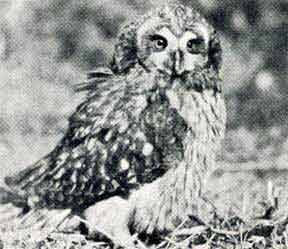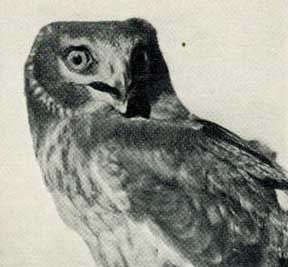Marshland Dwellers
By LEWIS WAYNE WALKER
Nature Magazine, September 1937
From out of the mass of cat-tails, bullrushes, and other tall reeds come many interesting sounds. In spring there sometimes can be heard a mysterious pumping, yet it comes from a swamp in which you know there are no human inhabitants. If you slowly slip up to the source of this noise and are successful in finding its maker, you have found one of the most interesting of the feathered folk-an American bittern. It is almost of the same form as the great blue heron, but is somewhat smaller and of stockier build. The bill is like a javelin, long and sharply pointed. In the bird's ordinary routine this is used by its owner to spear frogs, mice and small fish, but when the bird is wounded it is used for defense-often against man, the bittern's worst enemy. The muscles of the neck are strong and powerful, and the beak is usually launched with unerring aim. If you meet one of these birds in the bullrushes, it is well to keep several feet away, or the results of the encounter may be disastrous.

THE SHORT-EARED OWL
Sometimes there is seen flitting over the marshland at twilight a phantom form dressed in brown-the short-eared owl. Perhaps when you are wandering around you will come upon this bird's nest. It is not placed in the trees, as are the nests of most other birds, but is situated on the ground hidden among the heavy growths of weeds. This bird's eggs are white and nearly round. When the young are first hatched they are clothed in a soft down, similar to that of a baby chick. Lying about the nest will be many pellets, the cast-off refuse of the owl's past meals. I examined forty-four of these disgorged pellets and found that they contained the remains of sixty-six rodents, and only three birds. The sixty-six rodents, had they lived, would have destroyed many more birds than the owl did, as they continually rob birds' nests of the eggs and young, and sometimes even get the parent birds.
Another marshland dweller is the marsh hawk. He may be easily identified by the white patch on his rump, and the upturned ends of his wings. Like the short eared owl, he also is often killed needlessly, for the good he does in catching rodents far outweighs the little harm he does in catching birds. The father bird of this species is a light gray color, but the mother and all the young under a year old are reddish-brown. A member of the United States Biological Survey made a study of the bob-whites in Georgia. He found that the marsh hawk occasionally ate this game bird. To the ordinary thinker this would mean: "Kill the marsh hawk," but the investigator looked into the other food items of the hawk, and found that cotton rats made up about 75 percent of it. During the breeding season of the bob-whites the cotton rats eat many of their eggs and young. In this way it was discovered that, while the hawk may be an enemy to an occasional individual bird, to the race or species he is a valuable benefactor because he destroys their worst enemy.

THE MARSH HAWK
In the spring of the year there can often be heard from the marshes a pleasing rapid warble. On closer investigation it will be found to come from a diminutive bird, the marsh wren. As a rule he utters this melodious note while on the wing and seems to be fairly bubbling over with joy and happiness. A knock at the front door of his roofed-over home, or a call on any of these marshland dwellers will well repay your efforts.
 Printer-friendly version
Printer-friendly version
